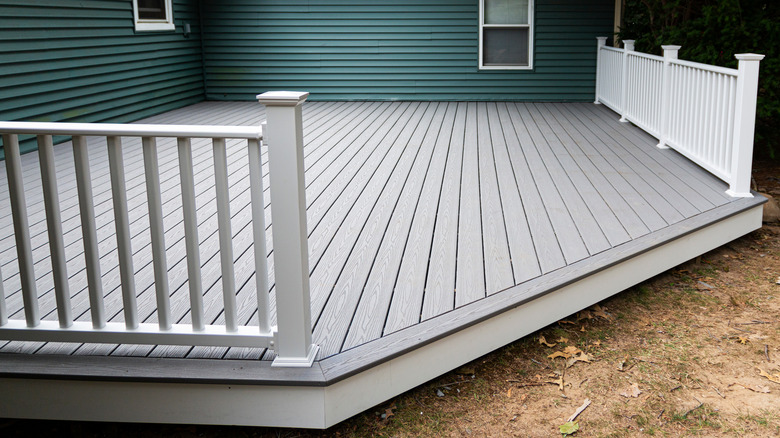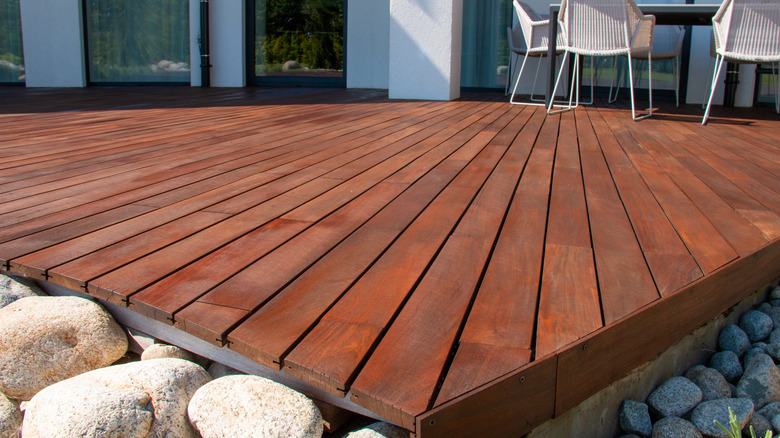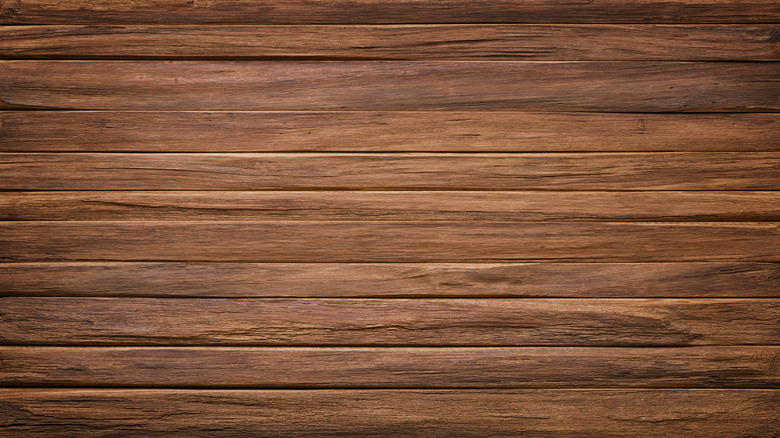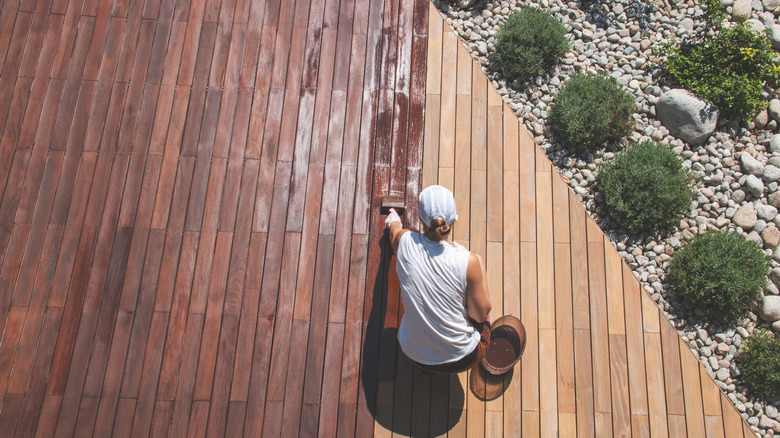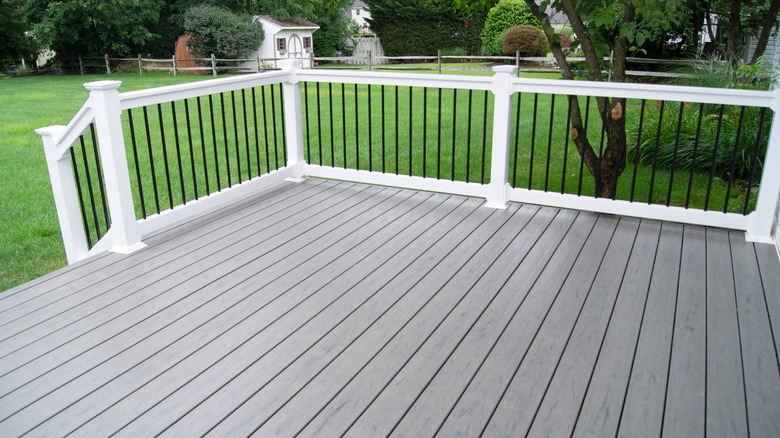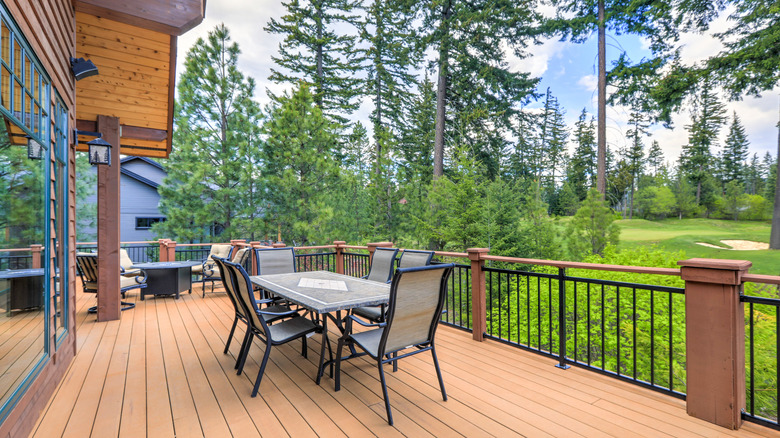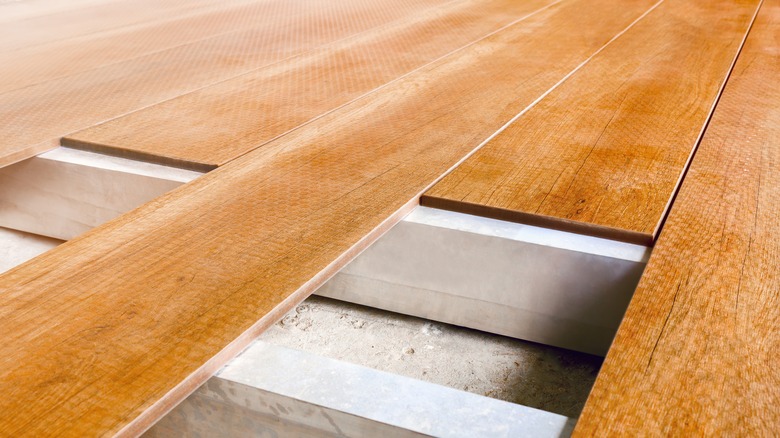Decking Mistakes Everyone Makes In Their Outdoor Space
Outdoor decking is a staple feature in many American homes. These exterior spaces provide an amazing array of functionality and comfort to any property. A deck extends the living space outward from a living room or bedroom, offering a totally new environment and vibe for homeowners, family members, and guests to enjoy (via Decks.com).
Building this feature is a great way to introduce a new area to host friends or simply relax at the end of a long day. Outdoor living has become a highly sought-after extremity of the home and for good reason: According to the American Psychological Association, spending time outside provides a wealth of mental health benefits.
It's also a great idea to add deck space to your home to increase the financial value and the overall utility of the property, yet it can be difficult to get the construction right, especially if you're performing a DIY build. Decks aren't the most difficult project a homeowner could take on in this realm, but there are some simple problems that can arise throughout the build.
Avoiding these deck building and maintenance mistakes can help you start enjoying the space more quickly and prevent issues from arising in the space with greater confidence.
Misjudging the garden space and coverage area
One of the first issues a homeowner building a new deck will encounter is the decision over how large the new addition will be. A deck that's too small won't properly provide the space you need to place key pieces of furniture or spread out across the space for ample relaxation. Armadillo Deck reports a new decking addition should typically be no larger than 20% of the total area of the home it's placed against or surrounds. Of course, this acts as a general rule of thumb, and a larger or smaller space that fits in with your precise needs might work better for your unique home.
Decking naturally takes away from the green space that's available beyond the interior limits of the property. It's therefore essential to take time planning out the extension for the best blend of functional space and luscious greenery that continues to persist beyond it.
Placing boards too close together
Installing a new wooden decking surface comes with a few technical considerations that can easily be overlooked by those who aren't professional installers. While crafting a backyard deck doesn't have to be a difficult build, there are some key (and simple) features to remember when working on the construction that will make a huge difference down the line.
Decks Direct notes that dried hardwoods and lumber from your local home improvement store will often require spacing of ⅛-inch while installing to account for the pre-shrunk nature of the planks. Leaving small gaps in the wooden deck is essential to wicking away water, providing breathability, and ensuring the natural expansion and contraction the boards will experience throughout the year doesn't leave lasting damage, warping the decking in a short amount of time and reducing your new amenity to nothing more than a huge hassle.
To ensure the proper amount of built-in spacing, use a number of small shims to generate this buffer space along the entire length of each new board while fastening it to the foundation elements.
On the other hand, if you're installing boards that are known as green wood (planks that haven't been kiln-dried as part of their treatment process), then installing the boards without this gap will give the right amount of spacing after a month or so when the boards dry out and settle into place.
Sealing or staining the deck at the wrong time
Seal-a-Deck recommends waiting about a month to seal or stain a newly laid deck. It's common to see DIYers seal their deck immediately, or wait for an extended period of time to complete the staining or sealing process (thinking that the new boards don't need it in the first season or year after installation).
Wood is a living thing, even after it's been chopped off of a tree and milled into planks to be used in construction. The boards that will come to make up your new decking will contain natural oils and glue-like elements that maintain the structure of the wood fibers within the physical material. These oils and other compounds protect the lumber from UV rays and liquid penetration from rain or snow.
Over time, the wood will lose its natural protective layer, and this is when you'll want to restain or reseal the decking to provide a renewal of this coating. In today's lumber marketplace, waiting about 30 days to perform a seal or stain will give your boards the best mix of natural oil remnants and an ingrained protective layer that will transform the deck into a color shade or stain variety that best corresponds to your style.
Failing to install rails along the deck's edge
Decking that's placed directly on the ground (typically using a concrete slab as a foundation) won't need railings, but any deck that's lifted off the ground to accommodate for seamless access from a raised section of the house will need to include railings (via Decks.com). Every building project will be unique, so checking with your local building codes to gain a comprehensive understanding of the particular railing needs that go along with your deck's specifications will give you the best in safety and code compliance.
Railings are a must because they provide a key safety element that can't be found though other means. A deck that's raised off the ground is a potential falling hazard, and even the shortest of falls can be detrimental to the physical and mental health of a homeowner or one of their guests (not to mention a potential liability issue if the person harmed is a guest).
Installing railings might not seem important if the deck is raised only a minimal height off the ground, but the added comfort and protection that this feature allows for is crucial to the completion of any deck construction. As well, railings complete the look of the space, making for a more luxurious appearance that's sure to turn heads.
Attaching the ledger board incorrectly
The ledger board is a crucial element in creating the seamless connection of the deck and home. A new deck isn't truly a part of the property unless it's tied directly into the existing structure of the house: To do this, DIYers and professionals make use of a ledger board to fasten adjacent components together.
A novice builder may not remove external sheathing and other parts of the exterior of the home before creating the ledger board addition that will form the basis for all of the remaining construction. Pros know that this component acts like a shelf on the existing structure, and creates a stable and sturdy point of contact to fasten the outward facing elements to the home. This will prevent swaying in the wind, or a pulling away of the deck through shifting soil issues beneath the home.
Removing elements from the side of the home to arrive at the base layer (and cleaning this surface, of course), will give you the best possible fit for your ledger board, according to Trex. Instead of fastening this element to a part of the home that can and probably will move over time, attaching the ledger board directly to the home is essential.
Not investing in quality wood
When it comes to buying wood for your deck, you may want to save money, but you also should consider how important it is to invest in quality materials. The better the wood, the longer your deck will last, for one. Plus, higher-quality wood is going to look better. According to Kebony, you should opt for hardwoods as opposed to softwoods, as the former will better withstand both the test of time and the elements that can ravage your deck every season.
Kebony suggests pressure-treated wood if you want to shoot for a more affordable option for your deck; it will last longer than your basic softwoods, but bear in mind this isn't as wise of a choice as hardwoods. Unfortunately, the chemical treatment used to create pressure-treated wood doesn't prevent the wood from splintering — and those chemicals may give you an infection if you don't keep the deck sanded and in pristine condition.
